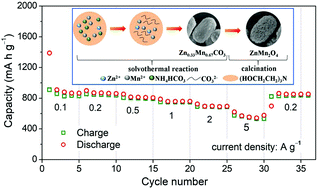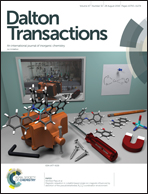Rice-shaped porous ZnMn2O4 microparticles as advanced anode materials for lithium-ion batteries†
Abstract
In this work, novel rice-shaped porous ZnMn2O4 microparticles made of nanoparticles were successfully prepared for the first time by the calcination of Zn0.33Mn0.67CO3 precursors synthesized using a facile triethanolamine-assisted solvothermal method. The effect of solvothermal reaction time on the crystallinity and morphology of Zn0.33Mn0.67CO3 precursors is discussed. The obtained ZnMn2O4 microparticles have lengths of ca. 1.6 μm and widths of ca. 0.9 μm, while the primary nanoparticles are in sizes of ca. 25–70 nm. As a potential anode material for lithium-ion batteries, the ZnMn2O4 microparticles give a large reversible discharge capacity of 892 mA h g−1 at 0.2 A g−1, superior cyclability (95% capacity retention after 550 cycles at 2 A g−1), and excellent rate capability (571 mA h g−1 at 5 A g−1). The outstanding electrochemical performances of the microparticle materials benefit from the suitable micro-/nanoparticle sizes, hierarchical porous structures, and strong interconnected 3D frameworks, which shorten the path lengths for ionic transport, accommodate volume expansion/contraction, and maintain the structural integrity of electrodes during the cycling process.



 Please wait while we load your content...
Please wait while we load your content...